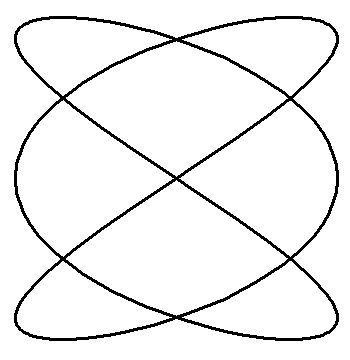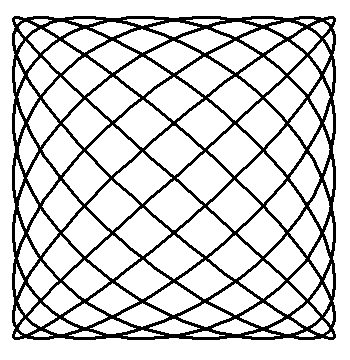Lissajous curve
|
|
Lissajous-Figur_1_zu_3_(Oszilloskop).jpg
3D_Lissajous_figure_(9,_4,_1).jpg
In mathematics, a Lissajous curve (Lissajous figure or Bowditch curve) is the graph of the system of parametric equations
- <math>x=A\sin(at+\delta),\quad y=B\sin(bt),<math>
which describes complex harmonic motion. This family of curves was investigated by Nathaniel Bowditch in 1815, and later in more detail by Jules Antoine Lissajous.
The appearance of the figure is highly sensitive to the ratio a/b. For a ratio of 1, the figure is an ellipse, with special cases including circles (A = B, δ = π/2 radians) and lines (δ = 0). Another simple Lissajous figure is the parabola (a/b = 2, δ = π/2). Other ratios produce more complicated curves, which are closed only if a/b is rational. The visual form of these curves is often suggestive of a three-dimensional knot, and indeed the many kinds of knots, including those known as Lissajous knots, project to the plane as Lissajous figures.
Lissajous figures are sometimes used in graphic design as logos. Examples include the logos of the Australian Broadcasting Corporation (a = 1, b = 3, δ = π/2) and the Lincoln Laboratory at MIT (a = 8, b = 6, δ = 0).
Lissajous curves can be traced mechanically by means of a harmonograph.
Below are some examples of Lissajous figures with δ = π/2, a = b, a odd, b even, |a − b| = 1.
External links
- Lissajous Curve at Mathworld (http://mathworld.wolfram.com/LissajousCurve.html)
- Animated Lissajous figures in Java (http://ibiblio.org/e-notes/Lis/Lissa.htm)
- About the Australian Broadcasting Corporation logo (http://www.abc.net.au/corp/hist1.htm)
- About the MIT Lincoln Laboratory logo (http://www.ll.mit.edu/about/lissajous.html)de:Lissajous-Figur
fr:Courbe de Lissajous nl:Lissajous-figuur ja:リサージュ曲線 pl:Krzywe Lissajous



